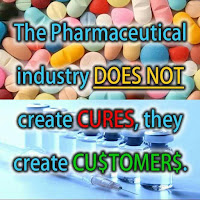Does the pharmaceutical industry manufacture diseases as well as drugs? In some cases, yes they do.
There's a word for that: "disease-mongering." Increasingly, more and more experts and researchers have raised the alarm and warn the medical establishment, government policy makers and the public of this disturbing and dangerous trend that I consider a public health hazard itself. According to BBC, "disease-mongering promotes non-existent diseases and exaggerates mild problems to boost profits."
Researchers at Newcastle University in Australia said drug companies are putting healthy people at risk by "medicalizing" conditions such as menopause (too often treated as a disorder when it's really a normal part of life) or in the case of irritable bowel syndrome, it is being promoted as a serious illness needing therapy when it is usually just a mild problem.

A good example is ADHD (Attention Deficit Hyperactivity Disorder). Many pediatricians bend over backwards to make the diagnosis and start children on dangerous chemical drugs at that tender age. Now comes the bombshell. Before his death, Dr. Leon Eisenberg admitted to Der Spiegel, the German magazine, that ADHD is a fictitious disease which they put together in 1968 for the benefit of drug companies in the new disease classification at that time of the DSM or Diagnostic and Statistical Manual of Mental Diseases, the bible in Psychiatry for decades. Dr. Eisenberg's contribution to mental disease by invention and committee consensus has resulted in drugging millions of children from preschool age through high school who were often prescribed Ritalin. Ritalin was tested by the Brookhaven National Laboratory (BNL) which found that it is pharmacologically similar to cocaine with perhaps even worse brain damaging potential.
Even risks factors such as high cholesterol and high blood pressure are being reclassified as diseases in their own right - hypercholesterolemia and hypertension, respectively - with falling thresholds resulting in more people considered to be sick.
Lynn Payer, author of "Disease-Mongers: How Doctors, Drug Companies, and Insurers Are Making You Feel Sick" wrote "Disease-mongering—trying to convince essentially well people that they are sick, or slightly sick people that they are very ill—is big business." Some critics characterize it as a vicious cycle in which businesses invent new diseases to match their existing drugs.
Take for example shyness. Excessive shyness is now a disorder called "social anxiety disorder" or social phobia. In October 2003 the FDA approved Paxil as treatment for social phobia.' "Shyness is a new disease invented by Glaxo" said Sidney Wolfe, executive director of the Public Citizen's Health Research Group in Washington, DC. Worse, in the US which is one of the few countries that allow direct-to-consumer advertising for medications, the consumers are being bombarded daily with ads which has a major impact on their view of a disease or "disease." The ads for Paxil in the late 1990s suggested that one in eight Americans had social anxiety disorder. "One in eight Americans! This is clearly an absurd fiction. The point of that is to try and make ordinary people feel sick", fumed one concerned expert.
Of course, some of these newly discovered diseases are real. There are two extremes in this issue: those who over-promote the "pill for every ill" philosophy and those overly suspicious critics who view diseases as being invented. The truth is somewhere in between. But if the medical establishment is not careful and vigilant, our doctors will become like our lawmakers in congress who are being controlled by the lobbyists and their corporate sponsors.
Some of these new "diseases" are really quite interesting. Take, for example, "Shift work sleep disorder" or SWSD. According to ICD 10, the medical coding standard often used by healthcare providers, insurers and Medicare, it is a circadian rhythm sleep disorder characterized by insomnia and excessive sleepiness affecting people whose work hours overlap with the typical sleep period. SWSD is yet another "disease" being promoted by Big Pharma for the sole purpose of selling drugs like Nuvigil, sold by Teva Pharmaceuticals. The fictional narrative is that those poor night shift nurses, for example, who suffer from excessive sleepiness are not simply tired because they are out of sync with the sun, the tiredness they feel when they stay up all night is actually a disease requiring medication. Yet one of the most common side effects of Nuvigil, the treatment for SWSD, is, ironically, also insomnia! Nuvigil is also a highly addictive controlled substance. Oh, those poor nurses (including my sister in Maryland) who are doing the graveyard shift! Avoid Nuvigil at all costs if you don't have to.

The latest "disease" to grab the limelight is "Hypoactive Sexual Desire Disorder" or HSDD. Women who are supposed to suffer from this new condition are being treated with flinbanserin from Sprout Pharmaceuticals. It is popularly known as the pink Viagra. Researchers believe sex equality advocates, along with the drug industry, are creating a medical need where one doesn’t really exist.
As earlier mentioned, one of the "dark" business models of Big Pharma is to invent a fake disease, promote the disease to push a new pill, then get as many people to take those pills as possible while Medicaid and Medicare programs write the checks. That's crazy.
But the blame is not purely in the hands of the drug industry. Top experts in their medical specialties who willingly become the spokespersons for these drug companies and even the unwitting doctors who help push the drugs for these new "diseases" are equally guilty. The pharmaceutical companies are very ingenious in the different ways they pump drugs into the medical system. According to James Ridgeway, techniques include "buying medical experts to put their names on articles written by the drug companies which can then be placed in medical journals; or hosting small casual dinners of docs to tell them about supposedly new and proven but still off-label uses for drugs. Docs get asked to come along for wonderful vacations with the dealers."
Dr Adriane Fugh-Berman, a Georgetown University physician, further exposed their methods on her article that appeared in the Boston Review. According to her, not only they "buy" the expert doctors, they also pump knowledge about the creepy new condition into the medical world through Continuing Medical Education, or CME, the process which helps doctors and other healthcare professionals keep abreast of new developments in their field.
Here’s how it works. Drug companies identify opinion leaders - influential healthcare professionals at academic medical centers. Selected opinion leaders are wooed. Opinion leaders whose perspectives "align" with the company’s marketing goals are then courted. A company may nurture relationships with targeted healthcare professionals over many years and will pay them to educate their peers at CME events and other settings. As expected, industry-paid speakers frequently deny espousing marketing messages. But these drug companies don't hire doctors to sell drugs. They hire them to sell diseases.
Very disturbing. On a lighter note, a former classmate in medical school, an ophthalmologist by trade, whom I recently had a quick reunion, amusingly quipped to me that had he known his family wants to travel extensively he would have taken residency training in internal medicine, implying that internists get much more corporate-sponsored travels for free than ophthalmologists. Of course, it's a joke (with some truth in it. LOL). I don't see serious harm on doctors attending pharma-sponsored conferences AS LONG AS they can keep their professional independence and critical thinking. I'm more concerned about the more impressionable younger doctors especially fresh residents who often take these new "knowledge and discoveries" that appeared in medical journals almost like unassailable truths.
 I believe success will be a lot easier if public support is strong which is really not the case as pointed out by Glyzelle with her 'why are there only very few people helping us?.' We all let these kids down. So what can we do as citizens? I believe public awareness (and acceptance) of their difficult struggle to survive is the first step in helping the homeless children in the streets of Manila, Bangkok, Mumbai, Rio de Janeiro, Durban in South Africa and anywhere else in the world where there are street children roaming around their cities. With strong public support, more effective social programs by both government and non-governmental organizations will get easily adopted and implemented.
I believe success will be a lot easier if public support is strong which is really not the case as pointed out by Glyzelle with her 'why are there only very few people helping us?.' We all let these kids down. So what can we do as citizens? I believe public awareness (and acceptance) of their difficult struggle to survive is the first step in helping the homeless children in the streets of Manila, Bangkok, Mumbai, Rio de Janeiro, Durban in South Africa and anywhere else in the world where there are street children roaming around their cities. With strong public support, more effective social programs by both government and non-governmental organizations will get easily adopted and implemented.











